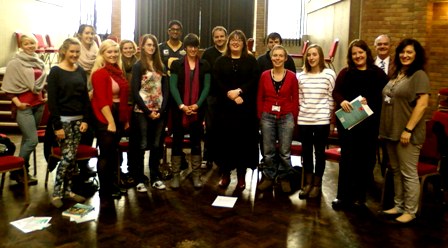A gloriously sunlit October day, suitable for rehearsing the first part of Poulenc’s Exultate Deo. This piece really has the light of the sun glowing through it in the second section, ‘Jubilate Deo,’ with Poulenc’s trademark musical language of added-sixth and seventh chords and prominent major second passing notes; there’s a terrific sense of freedom to the piece, both harmonically and rhythmically in the way the time-signatures changes between three, four and five crotchets in the bar.
Circle Time followed, where we broke ranks and stood around in a circle to sing the section of the Poulenc that we’d learned; it was amazing to stand surrounded by the colourful chords and exuberant harmony of the piece. And a great way to test the integrity of the voice-parts: in general, a fairly sound effort – the odd, typically Poulenc, dissonant sonority needed careful attention, but otherwise an exciting start.
Victoria’s Ave Maria is another motet which has great rhythmic freedom – occasionally there’s a dance-feel that interrupts the regular metric feel, as though he is eager to dance but feels he can’t within the confines of a formal sacred motet, but it’s uncontrollable and sometimes can’t help but burst through. Unlock the dance-rhythm in music, and it comes alive…

Hail, Bright Cecilians!
And here are some of us: Reading Week and flu claimed the others.

Find the ‘right’ place in Eliot Hall and if you close your eyes you might think you are in the singing in of one of our large parish churches or cathedrals! Stand in the ‘wrong’ place and the sound is bouncing off every surface in all directions and you get very little feedback. Anyone want to write a PhD thesis on the Hall’s acoustic properties? Go on you know you want to!
Does that mean we would also have to rehearse in Rutherford Hall and the Darwin Conference Suite, in order to provide comparative examples ?!
Rutherford is interesting because of the wooden canopy over the hall and I wonder if it might have been installed on purpose given the vagaries of the Eliot acoustic. Do we know if it has ever been used for music performances? Darwin? Well have you ever sung in a carpet warehouse? But a very good comparative example.
Talking of spaces and music…who advises about acoustic properties in a new build? Yes, folks, I’m thinking of the music building which will be next to the Gulb. How are acoustics planned? Can we plan with suitable dimensions and materials so that we have the acoustics of the Wigmore Hall?